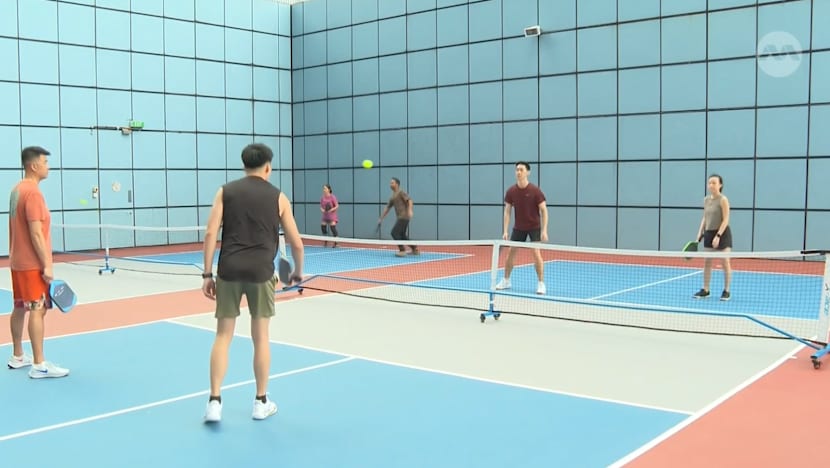Some Singapore clinics report rise in pickleball injuries as sport’s popularity surges
Common pickleball injuries include knee and ankle sprains, shoulder and elbow strains, and in severe cases, eye injuries from being hit by the ball.

A pickleball court in Singapore.

This audio is generated by an AI tool.
SINGAPORE: What began as a fun way to stay active is now landing more pickleball players in doctors’ offices.
Several clinics told CNA that the number of patients with pickleball-related injuries has doubled as the sport’s popularity surges.
Doctors are treating cases ranging from muscle strains to eye trauma, as the sport’s fast pace and competitive edge test the limits of casual players trying to stay fit.
Pickleball fever has swept across the island in recent years, attracting thousands with its easy-to-learn gameplay and social appeal.
The sport combines aspects of badminton, tennis and table tennis, and can be played both indoors and outdoors – usually at badminton courts.
“The fun part about pickleball is that it is easy to pick up. But to play well and all, it takes a lot of time, effort and training,” one pickleball player told CNA.
SINGAPORE’S PICKLEBALL BOOM
Online pickleball groups have sprouted across Singapore, helping newcomers find playing partners and communities.
But as the sport’s popularity surges, doctors are reporting an increase in injuries among players pushing themselves too hard.
Arete Orthopaedic Centre, for instance, has seen twice as many patients with pickleball-related injuries this year, compared with last year.
Dr Wang Lushun, senior consultant orthopaedic surgeon at the clinic, said many players underestimate the sport’s physical demands.
Most cases he has treated are over 40 years of age and prone to tendon or joint issues, or beginners who lack proper form and equipment. Some used to be avid badminton or tennis players looking for a less intense alternative, only to get wounded playing pickleball.
“This game brings certain kinds of challenges that are different in the mechanics (compared to other paddle or racquet sports). In pickleball, there are a lot of sudden side-to-side movements, so that can cause knee twisting (and) ankle twisting,” Dr Wang said.
“There's also quite a lot of forward and backward play, because you go in for the drop shot and then you may need to run backwards a lot. All these things can catch people off guard, so they might fall.”
Common injuries in pickleball include knee and ankle sprains or ligament tears, as well as shoulder and elbow strains resulting from falls or repetitive swinging motions.
In more serious cases, players may be struck in the eye by the ball – leading to anything from a black eye to a detached retina.
AVOIDING INJURIES
Physiotherapists told CNA that many injuries happen because players overlook the strain pickleball places on the body, assuming it is less strenuous than other sports.
Some players also continue playing through pain, worsening their injuries and extending recovery times.
Mr Chin Yi Khern, a physiotherapist at Regis Wellness, said: “These injuries often occur when people jump into pickleball too quickly, either from a previously sedentary lifestyle or picking it up without any guidance on the techniques of pickleball.
“All these can actually lead to excessive loading of the joints and muscles.”
He added that office workers and others who are typically less physically active often have tighter or weaker muscles from spending long hours in the same posture.
“When he or she starts to play pickleball, the deconditioned joints and muscles will be subject to increased load, and hence they can become more prone to injuries,” said Mr Chin.
“Additionally, without fundamentals or movements in pickleball, some parts such as the wrist and the lower back may (have to) compensate, and this can lead to even more stress and load in the joints and muscles.”
Medical professionals told CNA that the sport’s growing popularity is encouraging as it gets more people active.
However, they recommend that beginners start with shorter sessions and gradually increase the intensity.
They added that proper warm-ups, appropriate gear, correct technique and knowing one’s limits are key to staying injury-free.



















